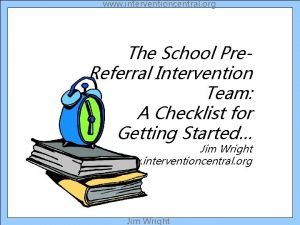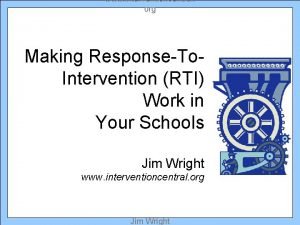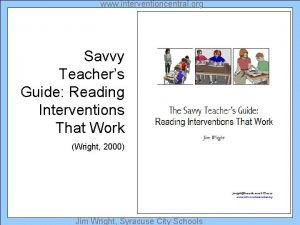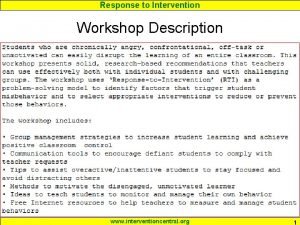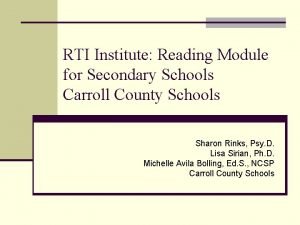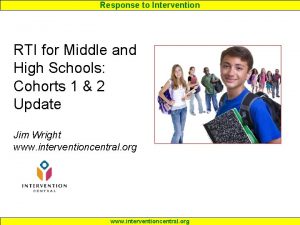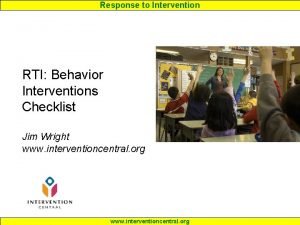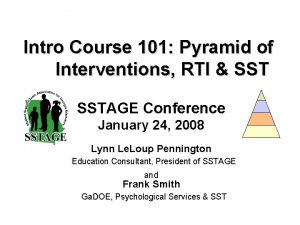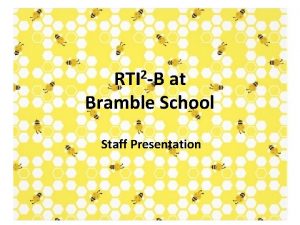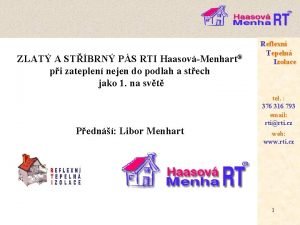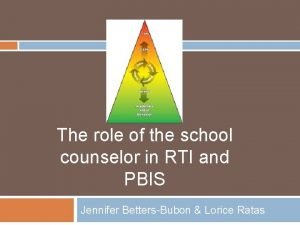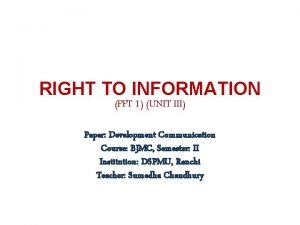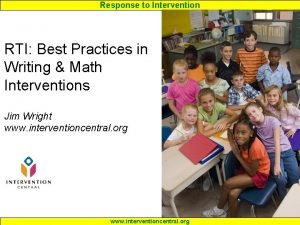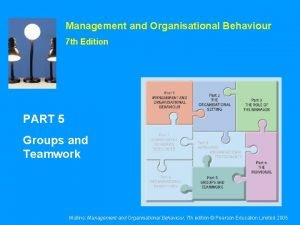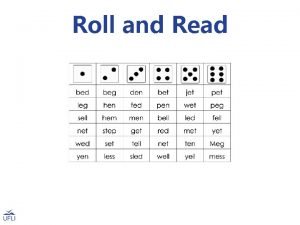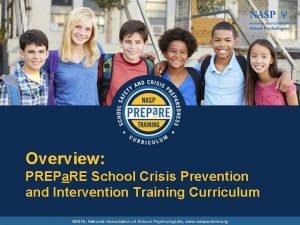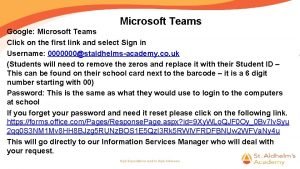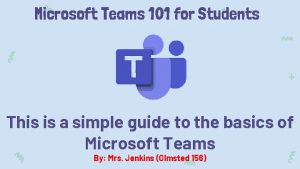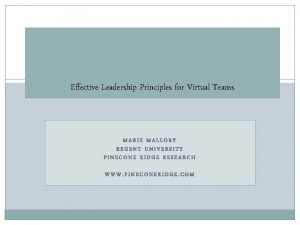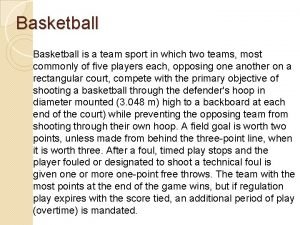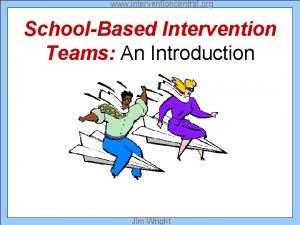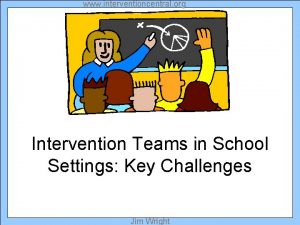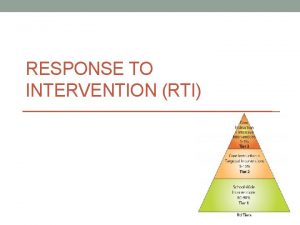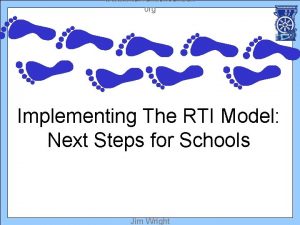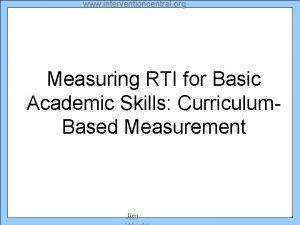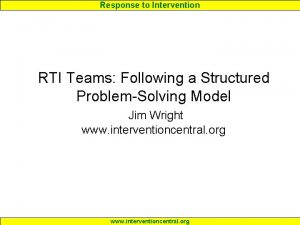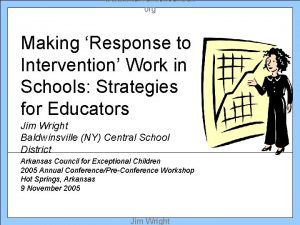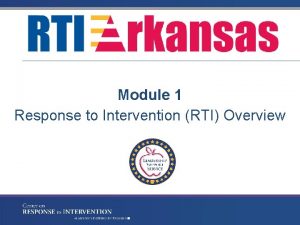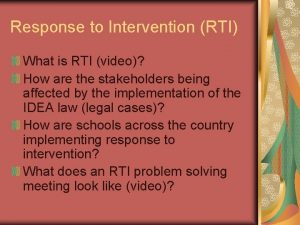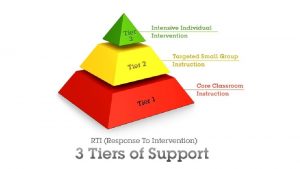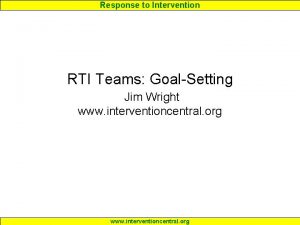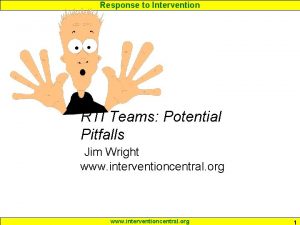www interventioncentral org RTI and Intervention Teams Following
















































































- Slides: 80

www. interventioncentral. org RTI and Intervention Teams: Following a Structured Problem-Solving Model Jim Wright

www. interventioncentral. org 1. Identify & Verify the Scope of the Problem 4. Monitor Student Progress & Evaluate Outcome 2. Select Interventions That Address ‘Root Cause’ 3. Set Goals for Improvement Jim Wright

www. interventioncentral. org School-Based Intervention Teams: An Introduction Jim Wright

www. interventioncentral. org “Everybody is entitled to their own opinion but they’re not entitled to their own facts. The data is the data. ” Dr. Maria Spiropulu, Physicist New York Times, 30 September 2003 (D. Overbye) Other dimensions? She’s in pursuit. F 1, F 4 Jim Wright

www. interventioncentral. org Workshop Goals… In this workshop, you will learn: q About the history of the SBIT project q How pre-referral intervention teams can help schools to support ‘struggling learners’ in general-education classrooms q What specific roles are assigned to SBIT members q How to run an SBIT meeting that follows a structured problem-solving process q How to create a plan to start a prereferral intervention team in your own school Jim Wright

www. interventioncentral. org SBIT Meeting Process Student Assessment Research-Based Interventions Jim Wright

www. interventioncentral. org The School-Based Intervention Team (SBIT) Project: Definition • Teams of educators at a school are trained to work together as effective problem-solvers. • SBIT Teams are made up of volunteers drawn from general- and special-education teachers and support staff. • These teams use a structured meeting process to identify the underlying reasons that a student might be experiencing academic or behavioral difficulties • The team helps the referring teacher to put together practical, classroom-friendly interventions to address those student problems. Jim Wright

www. interventioncentral. org Core Elements • SBIT has diverse representation including classroom teachers • SBIT members have a relationship with the referring teacher based on equity and a collegial relationship • The SBIT process is collaborative and confidential • Parents are involved in the SBIT process. At a minimum, they are informed about the referral and meeting outcome. Jim Wright

www. interventioncentral. org Core Elements (Cont. ) • The SBIT process is defined and conducted in a structured problemsolving format • The focus of SBIT is on the student within the classroom/school environment • The referring teacher’s concerns are explored, defined, and prioritized • The SBIT recommends interventions that have been documented to be effective in school settings Jim Wright

www. interventioncentral. org Team Roles • • • Coordinator Facilitator Recorder Time Keeper Case Liaison Jim Wright

www. interventioncentral. org Team Roles • Coordinator – The only non-rotating role – Makes sure referrals are complete and that a case liaison is assigned – Notifies SBIT members of days, times, and locations of meetings – Coordinates the assignment of substitutes for teachers attending the SBIT meeting Jim Wright

www. interventioncentral. org Team Roles • Facilitator – Establishes and maintains a supportive atmosphere – Keeps the meeting agenda goal oriented – Pay special attention to process issues – Attempts to elicit an appropriate level of agreement throughout the process – Helps resolve conflicts in the group Jim Wright

www. interventioncentral. org Team Roles • Recorder – Keeps an accurate, concise record of the meeting using the meeting minutes form – Asks for clarification about key information – Assures all relevant information is obtained and recorded Jim Wright

www. interventioncentral. org Team Roles • Time Keeper – Monitors how far a team has progressed given the guidelines in the meeting minutes forms – Prompts the team to keep focused on the issue at hand – Helps the team come to closure when time is running out Jim Wright

www. interventioncentral. org Team Roles • Case Liaison – Supports the referring teacher throughout the process – Helps referring teacher complete the referral form – Consults with referring teacher about types of assessment techniques that might be useful Jim Wright

www. interventioncentral. org Team Roles • Case Liaison (con’t) – Assists the teacher in collecting information prior to the meeting – Consults with the teacher concerning interventions and assessment strategies planned during the SBIT meeting – Assesses the degree to which the interventions and assessment procedures were implemented as designed Jim Wright

www. interventioncentral. org School-Based Intervention Teams: Express Meeting & Related Resources Jim Wright

www. interventioncentral. org SBIT Express Initial Meeting Minutes Form: Cover Sheet Jim Wright

www. interventioncentral. org SBIT Introductory Script Jim Wright

www. interventioncentral. org SBIT Introductory Script Welcome to this initial School-Based Intervention Team meeting. We are meeting with you today to discuss concerns that you have about a student, _________. The purpose of this meeting is for us all to work together to come up with practical ideas to help this student to be more successful in school. I am the facilitator for today’s meeting. The person taking notes during the meeting will be _________. The case liaison for this student is ______. The time keeper for the meeting is _________. Jim Wright

www. interventioncentral. org SBIT Introductory Script (Cont. ) You can expect this meeting to last about ____ minutes. By the time you leave, we should have a complete student intervention plan put together to help address your concerns. Our team and you have a lot to do today and only limited time in which to do it. To help us to work efficiently and not waste your time, we will follow a structured problem-solving model that goes through several stages. Jim Wright

www. interventioncentral. org SBIT Introductory Script (Cont. ) Together, our team and you will: – Assess your major concerns about the student – Help you to pick the one or two most important student concerns for us to work on today – Set specific student goals for improvement – Design an intervention plan with strategies to help that student improve, and – Decide how to share information about this plan with the student’s parent(s) Jim Wright

www. interventioncentral. org SBIT Introductory Script (Cont. ) As the student’s teacher, you are the most important participant in this meeting. Please let us know at any time if you disagree with, or have questions about, our suggestions. Our meeting will not be a success unless you feel that the intervention ideas that we offer will address the student’s difficulties and are feasible for you to do. Jim Wright

www. interventioncentral. org SBIT Introductory Script (Cont. ) Our meeting notes will document the student’s referral concerns and the intervention plan that we come up with. These notes may be shared with others who are not here today, including child’s parent(s) and the building administrator. However, we ask that everyone here keep the conversations that take place at this meeting confidential. Do you have any questions? Jim Wright

www. interventioncentral. org School-Based Intervention Teams: Quick. Guide Jim Wright

www. interventioncentral. org SBIT Quick. Guide Jim Wright

www. interventioncentral. org SBIT Consultative Process Step 1: Assess Teacher Concerns Step 2: Inventory Student Strengths and Talents Step 3: Review Baseline Data Step 4: Select Target Teacher Concerns Step 5: Set Goals Step 6: Design an Intervention Plan Step 7: Method of Monitoring Student Progress Step 8: Plan How to Share Information with the Student’s Parent(s) Step 9: Review the Intervention and Monitoring Plans Jim Wright

www. interventioncentral. org 5 -10 Minutes Step 1: Assess Teacher Concerns Jim Wright

www. interventioncentral. org SBIT Initial Meeting Quick. Guide… Step 1: Assess Teacher Concerns: GOALS • Allow the teacher to discuss major referral concerns • Review relevant background information, including: üCurriculum-based assessment (for academic concerns) üDirect observation data (for academic /behavioral concerns) üTeacher Behavior Report Cards (for academic/ behavioral concerns) üArchival information from student cumulative Jim Wright

www. interventioncentral. org SBIT Meeting: Step 1: Assess Teacher Concerns Jim Wright

www. interventioncentral. org SBIT Initial Meeting Quick. Guide… Step 1: Assess Teacher Concerns: SAMPLE QUESTIONS • Given the information in the referral form, what are specific difficulties that you would like to address today? • How is this student problem interfering with the student’s school performance? • What concern(s) led you to refer the student to this Team? • What information have we already collected that can shed some light on the identified Jim Wright

www. interventioncentral. org SBIT Initial Meeting Quick. Guide… Step 1: Assess Teacher Concerns The SBIT Team is ready to move on when… • Team members have a good understanding of teacher concerns, and have reviewed relevant background and baseline information on the student. Jim Wright

www. interventioncentral. org 5 Minutes Step 2: Inventory Student Strengths & Talents Jim Wright

www. interventioncentral. org SBIT Initial Meeting Quick. Guide… Step 2: Inventory Student Strengths & Talents: GOALS • Discuss and record the student’s strengths and talents, as well as those incentives that motivate the student. This information can be valuable during intervention planning to identify strategies that the student will be motivated to participate in. Jim Wright

www. interventioncentral. org SBIT Meeting: Step 2: Inventory Student Strengths Jim Wright

www. interventioncentral. org SBIT Initial Meeting Quick. Guide… Step 2: Inventory Student Strengths & Talents: SAMPLE QUESTIONS • What rewards or incentives have you noted in school that this child seems to look forward to? • What are some things that this student does well or enjoys doing around the classroom? • Please tell us a few of the student’s strengths, talents, or positive qualities that might be useful in designing interventions for him or her. • What are hobbies or topics of interest for this Jim Wright

www. interventioncentral. org SBIT Initial Meeting Quick. Guide… Step 2: Inventory Student Strengths & Talents The SBIT Team is ready to move on when… • The team has identified personal strengths, talents, and/or rewards that are likely to motivate the student if integrated into an intervention. Jim Wright

www. interventioncentral. org 5 Minutes Step 3: Review Baseline Data Jim Wright

www. interventioncentral. org SBIT Initial Meeting Quick. Guide… Step 3: Review Baseline Data: GOALS • Review any baseline data or background information that might be important in understanding the student’s academic or behavioral concerns Jim Wright

www. interventioncentral. org SBIT Meeting: Step 3: Review Baseline Data Jim Wright

www. interventioncentral. org SBIT Initial Meeting Quick. Guide… Step 3: Review Baseline Data : SAMPLE QUESTIONS • What curriculum-based data have we collected on this student’s academic skills? • What Daily Behavior Report Card data do we have on this student? • What is the student’s attendance record? • What disciplinary office referrals does this student have? Jim Wright

www. interventioncentral. org SBIT Initial Meeting Quick. Guide… Step 3: Review Baseline Data The SBIT Team is ready to move on when… • All key background information and baseline data have been reviewed. Jim Wright

www. interventioncentral. org 5 -10 Minutes Step 4: Select Target Teacher Concerns Jim Wright

www. interventioncentral. org SBIT Initial Meeting Quick. Guide… Step 4: Select Target Teacher Concerns: GOALS • Define the top 1 -2 teacher concerns in easily observable, measurable terms. • For behavioral concerns, understand the dimensions of the problem (e. g. , frequency, duration, and/or intensity) • For academic concerns, identify the presence of underlying academic skill deficits, mismatch between student skills and classroom instruction, etc. • For each teacher concern, decide on what functions may help to explain why the student displays the target. Jim concerns. Wright

www. interventioncentral. org SBIT Meeting: Step 4: Select Target Teacher Concerns Jim Wright

www. interventioncentral. org Reason/Function for Student’s Presenting Problem(s) in BEHAVIOR… • • Lacks necessary skills Has limited motivation Seeks attention from adults Seeks attention from peers Reacting to teasing/bullying Tries to escape from work demands of setting Seeks access to privileges, rewards Jim Wright

www. interventioncentral. org Reason/Function for Student’s Presenting Problem(s) in ACADEMICS… • Lacks necessary skills • Has limited motivation • Struggling academically in current instructional placement • Needs drill & practice Jim Wright

www. interventioncentral. org SBIT Initial Meeting Quick. Guide… Step 4: Select Target Teacher Concerns: SAMPLE QUESTIONS • What are the top one or two problems that you would like us to concentrate on today? • (Academic) What can you tell us about the student’s current skill levels, homework and classwork completion, attention to task, general motivation? • (Behavioral) How long does each behavioral outburst last? About how frequently do episodes occur? How severe are the behaviors that you are seeing? • (Behavioral) What kinds of things happen in the room just before the student has an outburst? Jim Wright

www. interventioncentral. org SBIT Initial Meeting Quick. Guide… Step 4: Select Target Teacher Concerns The SBIT Team is ready to move on when… • One or two primary teacher concerns have been established and stated in measurable terms (as behavioral and/or academic difficulties). • The referring teacher agrees with the selection and definition of the top 1 -2 problems. • The team and teacher agree on possible Jim Wright

www. interventioncentral. org 5 -10 Minutes Step 5: Set Observable, Measurable Goals Jim Wright

www. interventioncentral. org SBIT Initial Meeting Quick. Guide… Step 5: Set Observable Goals: GOALS • The team should estimate goals for improvement based on the time that will elapse between the initial and follow-up meeting • For each of the academic or behavioral referral concerns: üSelect at least two ways to monitor student progress. üset ambitious but realistic goals for improvement. Jim Wright

www. interventioncentral. org SBIT Meeting: Step 5: Set Observable, Measurable, Realistic Goals for Change (Academic) Jim Wright

www. interventioncentral. org SBIT Meeting: Step 5: Set Observable, Measurable, Realistic Goals for Change (Behavior) Jim Wright

www. interventioncentral. org SBIT Initial Meeting Quick. Guide… Step 5: Set Observable Goals: SAMPLE QUESTIONS • Does the monitoring information really measure the teacher’s referral concern? • Who will collect the monitoring information? • How frequently should data be collected? • How reliable/trustworthy is the information to be collected? • Who on the SBIT Team or in the building is available to monitor this student with: ücurriculum-based assessment? üdirect observation? Jim Wright

www. interventioncentral. org SBIT Initial Meeting Quick. Guide… Step 5: Set Observable Goals The SBIT Team is ready to move on when… • Ambitious but realistic student goals for improvement have been set. • At least two measures have been identified to track each referral concern. • The referring teacher agrees that both the goals for change and the measures selected are appropriate for this student case. Jim Wright

www. interventioncentral. org 15 -20 Minutes Step 6: Design an Intervention Plan Jim Wright

www. interventioncentral. org SBIT Initial Meeting Quick. Guide… Step 6: Design an Intervention Plan: GOALS • Select at least one intervention that addresses each selected referral concern. • Spell out the particulars of the intervention as a series of specific teacher-friendly steps • Note any important additional information about the intervention (e. g. , when, where, what specialized materials are needed, etc. ) Jim Wright

www. interventioncentral. org SBIT Meeting: Step 6: Design an Intervention Plan Jim Wright

www. interventioncentral. org SBIT Initial Meeting Quick. Guide… Step 6: Design an Intervention Plan: SAMPLE QUESTIONS • What intervention ideas would best meet this student’s needs? • What is it about this particular intervention that makes it likely to improve the student’s behavior or academic functioning in the area(s) identified? • Is there specialized training or materials that you feel are needed to carry out this intervention? • How can our Team assist you [the referring teacher] with the intervention? Jim Wright

www. interventioncentral. org SBIT Initial Meeting Quick. Guide… Step 6: Design an Intervention Plan The SBIT Team is ready to move on when… • The referring teacher and team members agree that the intervention: üdirectly addresses the identified concern(s). üis judged by the teacher to be acceptable, sensible, and achievable. üappears likely to achieve the desired goal. üis realistic, given the resources Jim Wright

www. interventioncentral. org 5 Minutes Step 7: Method of Monitoring Progress Jim Wright

www. interventioncentral. org SBIT Initial Meeting Quick. Guide… Step 7: Method of Monitoring Progress: GOALS • Determine • who will do progress-monitoring • how frequently monitoring will take place Jim Wright

www. interventioncentral. org SBIT Meeting: Step 7: Method of Monitoring Progress Jim Wright

www. interventioncentral. org SBIT Initial Meeting Quick. Guide… Step 7: Method of Progress-Monitoring: SAMPLE QUESTIONS • How often will we collect data on this student to document progress? • Who will be responsible for collecting and analyzing the data? Jim Wright

www. interventioncentral. org SBIT Initial Meeting Quick. Guide… Step 7: Method of Progress-Monitoring The SBIT Team is ready to move on when it has… • selected methods to monitor progress that are sensitive to short-term student gain • has assigned responsibility to specific staff members to collect the monitoring data Jim Wright

www. interventioncentral. org 5 Minutes Step 8: Plan How To Share Meeting Info With Parent(s) Jim Wright

www. interventioncentral. org SBIT Initial Meeting Quick. Guide… Step 8: Plan to Share Info With Parent: GOALS • Agree on who will contact the parent(s) to share the student’s intervention plan and invite the parent(s) to a future SBIT meeting. Jim Wright

www. interventioncentral. org SBIT Meeting: Step 8: Plan to Share Meeting Info With Student’s Parents Jim Wright

www. interventioncentral. org SBIT Initial Meeting Quick. Guide… Step 8: Plan to Share Info With Parent: SAMPLE QUESTIONS • What specific details about the intervention would be of greatest interest to the parent(s)? Jim Wright

www. interventioncentral. org SBIT Initial Meeting Quick. Guide… Step 8: Plan to Share Info With Parent The SBIT Team is ready to move on when… • At least one team member (who could be the referring teacher) has taken responsibility to contact the parent to share information about the student’s intervention plan and future SBIT meeting times and dates. Jim Wright

www. interventioncentral. org 5 Minutes Step 9: Review the Intervention & Monitoring Plans Jim Wright

www. interventioncentral. org SBIT Initial Meeting Quick. Guide… Step 9: Review Meeting Plans: GOALS • Review main points of the intervention and monitoring plans with referring teacher, other team members. • (Case Liaison) Schedule a time within next week to meet with the referring teacher to review the intervention plan; offer any needed assistance; ensure that the intervention is being put into place as planned. • Schedule a follow-up meeting (usually within 68 weeks of the initial SBIT meeting). • After the referring teacher leaves the meeting, complete the SBITJim. Team Meeting Debriefing Wright

www. interventioncentral. org SBIT Meeting: Step 9: Review Intervention & Monitoring Plans Jim Wright

www. interventioncentral. org SBIT Initial Meeting Quick. Guide… Step 9: Review Meeting Plans: SAMPLE QUESTIONS • Do the referring teacher and other members of our team know what their responsibilities are in carrying out the intervention and monitoring plans for this student? • Is our team able to support the teacher in identifying the most important referral concerns? • Did our team help the teacher to assemble a good intervention plan that is feasible and can be carried out with currently available resources? Jim Wright

www. interventioncentral. org SBIT Meeting Debriefing Form Jim Wright

www. interventioncentral. org SBIT Initial Meeting Quick. Guide… Step 7: Review Meeting Plans The SBIT Team is ready to adjourn! Jim Wright

www. interventioncentral. org SBIT Referral Form: Page 1 Jim Wright

www. interventioncentral. org SBIT Referral Form: Page 2 Jim Wright

www. interventioncentral. org Small-Group Activity: Complete SBIT Referral Form • As a group, read through all of the sections of the Referral Form • The member of your group who best knows the student that you are using as a ‘practice case’ should fill out the referral form on that student. • Provide assistance, coaching, and encouragement to the referring teacher as needed as he/she fills out the form. Jim Wright

www. interventioncentral. org Small-Group Activity: Practice Meeting • Select members of your group to serve as facilitator, recorder, time-keeper, & case liaison. • Consult your ‘Quick. Guide’ as the group moves through the steps of the meeting. • Run your mock-meeting as though it were the real thing. • Any member can call a ‘time-out’ to ask questions about the meeting process or to get feedback from other team members about his/her performance. Jim Wright
 Intervention central.com
Intervention central.com Interventioncentral.org
Interventioncentral.org Interventioncentral.org reading
Interventioncentral.org reading Interventioncentral.org
Interventioncentral.org Www.interventioncentral.org
Www.interventioncentral.org Transparency of good governance
Transparency of good governance Serp.doe.louisiana
Serp.doe.louisiana Subsplease.orf
Subsplease.orf Jim wright intervention central
Jim wright intervention central Rti scheduler
Rti scheduler Jim wright rti
Jim wright rti Rti interventions examples
Rti interventions examples Rti act 2005 introduction
Rti act 2005 introduction Hmrc rti gtax
Hmrc rti gtax Strömungsmelder sprinkleranlage
Strömungsmelder sprinkleranlage Rtiddsgen
Rtiddsgen Rti2b
Rti2b Rti meaning real estate
Rti meaning real estate Rti zeromq
Rti zeromq Rti portal rajasthan
Rti portal rajasthan Rti zeromq
Rti zeromq Pegasus opera 3 auto enrolment
Pegasus opera 3 auto enrolment Suo-moto meaning
Suo-moto meaning Rti izolace
Rti izolace Rti school counseling
Rti school counseling Right to information ppt
Right to information ppt Rti interventions list
Rti interventions list Upper respiratory tract
Upper respiratory tract Rti oregon
Rti oregon Jim wright rti
Jim wright rti Rti jaipur
Rti jaipur Chapter 10 motivating employees
Chapter 10 motivating employees Motivating and satisfying employees and teams
Motivating and satisfying employees and teams Is the individual internal process that energizes directs
Is the individual internal process that energizes directs Motivating and satisfying employees and teams
Motivating and satisfying employees and teams Copyright
Copyright 6-5 study guide and intervention rhombi and squares
6-5 study guide and intervention rhombi and squares Interactive and coactive groups
Interactive and coactive groups Peopleware: productive projects and teams
Peopleware: productive projects and teams What is the difference between a group and a team?
What is the difference between a group and a team? Groups and teams difference
Groups and teams difference Groups and teams difference
Groups and teams difference Persuasive communication
Persuasive communication Leading and working in teams
Leading and working in teams Understanding groups and managing work teams
Understanding groups and managing work teams Words with oi oy sound
Words with oi oy sound Understanding groups and teams
Understanding groups and teams Understanding groups and teams
Understanding groups and teams National programme for maternal and child
National programme for maternal and child Early warning intervention and monitoring system
Early warning intervention and monitoring system Cert iv in child youth and family intervention
Cert iv in child youth and family intervention Taxation and government intervention
Taxation and government intervention Check-in check-out intervention
Check-in check-out intervention School crisis prevention and intervention
School crisis prevention and intervention Petition vs intercession
Petition vs intercession 11-1 areas of parallelograms and triangles answer key
11-1 areas of parallelograms and triangles answer key Hybrid model of crisis intervention
Hybrid model of crisis intervention Work improvement teams singapore
Work improvement teams singapore Aim words list
Aim words list Unity teams basic
Unity teams basic Step ladder format
Step ladder format Tpot teams
Tpot teams Microsoft teams voicemail settings
Microsoft teams voicemail settings Team around the family meeting template
Team around the family meeting template Teams stadium
Teams stadium Microsoft teams channel management by sphereshield
Microsoft teams channel management by sphereshield Special teams drills
Special teams drills Autonomous work group
Autonomous work group Virtual teams are often slowed down by difficulty with
Virtual teams are often slowed down by difficulty with Organogram zelfsturende teams
Organogram zelfsturende teams Ukhosted accelerated reader
Ukhosted accelerated reader Ms teams 101
Ms teams 101 Microsoft windows office teams rajesh
Microsoft windows office teams rajesh Self-directing teams unleash
Self-directing teams unleash Keep change flip chart
Keep change flip chart Integrated process team
Integrated process team Principles of effective leadership in virtual teams
Principles of effective leadership in virtual teams Creating extraordinary teams
Creating extraordinary teams Basketball is a team sport in which two teams
Basketball is a team sport in which two teams Traditional teams
Traditional teams Cross functional team
Cross functional team
